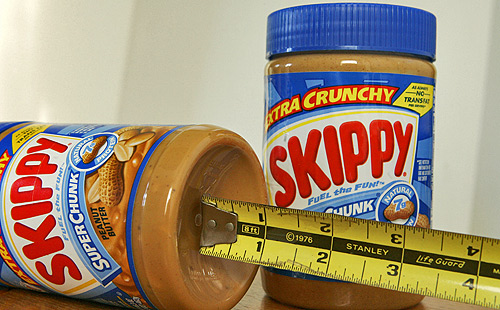 |
| The shelf tag still reads 11 oz. but is suddenly a 9 oz. bottle! |
 |
| Last week Gain Dish Liquid was 11 oz! |
I thought I'd share a past column I wrote regarding this issue that you might find interesting:
I was reminded this week as I was rotating my food storage how much every ounce counts. As I put my groceries away after a great week of shopping, specifically some Scrubbing Bubbles cleaner, I noticed that my 25-ounce can had mysteriously shrunken to only 22 ounces. Where did my extra 3 ounces go? No, it wasn’t a specially marked can with an extra 15% included for free and it wasn’t any type of special buy – it was just gone! My 3 ounces had vanished without a word from SC Johnson or anyone else.
 Package sizes are becoming smaller, but prices aren’t and The Great Shrink, as I call it, has actually been happening for years. Manufacturers, faced with a difficult economy have two choices, raise prices or reduce package sizes. Both money-saving methods are in practice today, but smaller package sizes aren’t readily noticed by consumers.
Package sizes are becoming smaller, but prices aren’t and The Great Shrink, as I call it, has actually been happening for years. Manufacturers, faced with a difficult economy have two choices, raise prices or reduce package sizes. Both money-saving methods are in practice today, but smaller package sizes aren’t readily noticed by consumers. You may recall the Dreyers ice cream fiasco of 2008, when cartons dropped from 1.75 to 1.5 ounces, much to consumers’ chagrin. "Downsizing is nothing but a sneaky price increase," says Edgar Dworsky, former Massachusetts assistant attorney general in the Consumer Protection Division. "I'm waiting to open a carton of eggs and see only 11."
 |
| Image Source: http://www.eatmedaily.com |
Many shoppers cringe at the thought of computing, either by calculator or brainpower, the cost per ounce on their grocery purchases each week. While these calculations may bring a slight increase in shopping time — size matters. More than ever shoppers need to know what they’re purchasing and at what cost.
 One thing to consider in deciding whether or not you have the time to bother with price-per-ounce costs is that nowadays many major grocer and retailers often do the work for you. Shelf tags today often list ounce costs for shoppers; no calculating required. If unit costs aren’t already listed, a small calculator tucked in your purse or coupon organization system will do the trick. And practically every cell phone on the market has a calculator application. I keep my phone in calculator mode during every shopping trip for some easy math. Plus, there’s the added benefit of becoming a math whiz for all the adding, subtracting and multiplication you’re doing in your head. In reality, price-per-ounce cost computing takes only seconds but can equal real savings.
One thing to consider in deciding whether or not you have the time to bother with price-per-ounce costs is that nowadays many major grocer and retailers often do the work for you. Shelf tags today often list ounce costs for shoppers; no calculating required. If unit costs aren’t already listed, a small calculator tucked in your purse or coupon organization system will do the trick. And practically every cell phone on the market has a calculator application. I keep my phone in calculator mode during every shopping trip for some easy math. Plus, there’s the added benefit of becoming a math whiz for all the adding, subtracting and multiplication you’re doing in your head. In reality, price-per-ounce cost computing takes only seconds but can equal real savings. Lastly, remember, bigger isn’t always better. The bigger the box doesn’t necessarily mean bigger savings. Just because you can buy cereal in 10-pound boxes at warehouse stores doesn’t mean your price-per-ounce costs are any kind of real savings. And, if you’re planning on using coupons to reduce your out-of-pocket expense, your savings will best be applied to the smallest packages allowable. In fact smaller boxes are almost always the bigger savings when using coupons.
So now I’m faced with the choice to clean only 85 percent of my bathtub in protest or buy more Scrubbing Bubbles. And while I’d definitely like less housework, like the rest of America I’ll just have to buy more – as I echo in a loud and bellowing voice with hands clenched, “Curse you, scum!” (That is unless my husband wouldn’t notice that his half of the tub still has a ring?). America may have to endure The Great Shrink for a while yet, but arming ourselves with per-unit costs can help shoppers make wiser purchases and smarter buys for their money.










I noticed the same thing with Charmin recently. The same 12=24 Big Rolls had 14% less sheets and an increase in price.
ReplyDelete